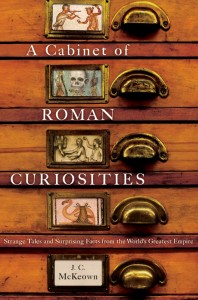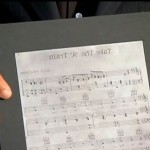This is the full author Q & A that I quoted just a teeny portion of in my review of A Cabinet of Roman Curiosities by J.C. McKeown. I emailed him the questions and he kindly emailed me back his answers.
Q: I’d like to know more about your factoid collection process. Had you taken any notes as Aulus Gellis had (Preface, pg. VIII), by jotting down oddities as you casually encountered them in your personal and professional reading, or did you review the sources explicitly to collect items that would serve as incentives for your Classical Latin exercises? Maybe some of both? Did you go through the sources all over again when you decided to make a book of it?
A: I have a tendency to enjoy and remember trivial facts and stories like these. The majority were gathered during my reading over the years. I like to read Latin and Greek for a couple of hours every day, regardless of what else I am doing, and my texts have a lot of passages underlined or commented on in the margins, so it was easy to pick them out.
I wasn’t originally setting out to write a book. I started using quirky facts in class to keep students interested in learning Latin and then, when I spun the Web site to accompany my textbook, Classical Latin, I incorporated interesting stories to appear randomly at the bottom of each page as an incentive for students to continue with the online exercises. It started with about 90 items and grew from there.
For a lot of the stuff that appears in the book it would be hard to go looking for it specifically. For example, nobody would really set out to inquire how many testicles the dictator Sulla had or, if they did want to know, the problem would be where to look, but the answer comes out of the blue right at the end of Justinian’s Digest – the cornerstone of so much modern Western law.
Q: Aelian describes the Byzantines as living in taverns and renting their homes to strangers. (Foreigners, pg. 110) Leeds University’s Clare Kelly Blazeby recently advanced a theory that mainland Greeks 500 – 700 years before Aelian was writing used their homes as taverns and brothels. Could there be a kernel of truth rooted in a Greek practice that spread to the eastern Hellenic world over time? Do you ever follow up on something you’ve encountered in the literature, even something fairly outlandish to our sensibilities, to see if there might be a historical basis for it?
A: This is a good example of my really not know what someone else could
make of it. It only made it into the book because it was curious. For what it’s worth, although Aelian wrote in Greek and obviously had access to a lot of very interesting sources now lost to us, he probably lived his whole life in Italy so maybe he is not the best authority for this sort of thing, but again I am not making a judgement on my source, just quoting it.
Q: I found myself following up on many individual curiosities. Additional research, pursuing a tangent, is so easy to do in the Internet era. In fact, it took me much longer to read your book than the number of pages and easy pace would suggest just because I kept running after factoids. Did you include hyperlinks to additional reading and original sources in the Classical Latin online exercises?
A: There are no hyperlinks in the text of Classical Latin itself. Many of the sources are not, I suspect, available online. I really regret not having easy and full online access to e.g. the Corpus Inscriptionum Latinarum, because it is so useful in lots of ways. On my Web site, www.jcmckeown.com, I did include links to interesting web sites under the tab Mundus Araneosus (a world full of webs).
Q: It seems to me A Cabinet of Roman Curiosities is a book that could become the pivot of a huge network of information if you had an online version. A companion DVD with links to online editions of the sources, for instance, or even a full digital version of the book where every reference, footnote and bibliographical credit is an active link. Can you envision putting together something like that even for a book that is also traditionally published? Would it increase your workload past the point of it being worthwhile?
A: I dare say this would all be possible, but I’m not the world’s greatest computer user and the idea of me being a spider at the center of a huge Web is improbable. In any case, my wife cannot abide spiders.
Q: Marcus Aurelius’ description (Medicine, pg. 70) of the public baths upended my long-held assumption that they were indicative of general hygiene. I never considered how dirty, stagnant, greasy and petri-dish-like these unchlorinated pools full of oiled down people must have been. Meanwhile, Pliny described the barbarian Gauls and Germans using soap. (Foreigners, pg. 104) Do you think we still carry biases about who is or isn’t “civilized” from the classical texts, even without consciously realizing it?
A: Good point. As an Irishman whose country the Romans did not consider worth conquering because the people would not even make good slaves, I’m glad to see there is an upsurge in interest in Celtic art, which really is powerful and beautiful in its utterly unclassical way. Rome must have been dreadful when, for example, three hundred oxen were sacrificed at one time. It’s appalling to think of the blood, esp. if they performed these rituals at the height of summer.
Q: There’s an exhibit at the National Constitution Center in Philadelphia right now called “Ancient Rome & America” about the powerful influence Roman mythology, politics, ideals, art and literature exerted on the nascent United States. The Founding Fathers and early leaders would have all been far more familiar with the classical authors than most of us are today. They would have been more like you, in fact, in that respect. Do you encounter the legacy of Rome everywhere you go, or do the vast differences between the Roman mindset and ours stand out more than the commonalities?
A: My wife says that I generally go around in a fog with little or no interest in anything outside our personal life that has happened since about A.D. 300. There is an implication in this question that I am looking for or finding lessons to be drawn from the past for the present and I’m flattered if you would think I have such a high purpose. I really don’t. Every reader will have to make up their own mind about the implications of each item in the book, if indeed there are any.
Q: I’m curious to know more about the early imperial plague pit found in 1876 that still reeked after almost 2,000 years. (Medicine, pg. 75) Bill Thayer’s excellent website pointed me to Rodolfo Lanciani’s 1888 book for an account of the find. Lanciani said the human remains turned to dust as soon as the pit was opened, but that the whole Servilian Agger area smelled revolting once dug up several years later, not the pit itself. What was your source?
A: If this were an academic book, I would have quoted my source. I’m pretty sure this item was a late candidate for entry into the book and I jotted it down casually. I’m sorry that I cannot tell you where I found it. I do remember talking to an archeologist colleague of mine to confirm the accuracy of what I was saying.
Q: What exactly did the primitive liposuction procedure performed on Caesianus’ son entail? (Medicine, pg. 68)
A: Pliny says that fat is not sensate, because it has neither veins nor arteries, and that this is why mice can nibble at living pigs. Then he goes straight on to say merely that “fat was withdrawn [literally “detracted”] from Apronius, and his body was relieved of the weight that made it impossible for him to move”.
Q: Is that one anecdote from Suetonius about Claudius’ slip of the tongue in front of the fighters in the Fucine sea battle (Spectacles, pg. 145) really the only source for the widespread belief that gladiators hailed the emperor with “we who are about to die salute you”?
A: I believe it is.
Q: You include reactions to antiquity from post-Fall Rome and Italy along with your ancient source material. Do you have a general interest in Italian history and culture, and if so, which came first: a passion for the literature or a passion for the place?
A: When I was student I spent all my summers in Greece and was a late bloomer in appreciating Italy. You may be thinking particularly of the “Wedding Cake” [ie, the Victor Emmanuel Monument], that utterly spoils the Capitol. I think I said that just because I find it an appalling and quite inappropriate building. I’m mostly just interested in things that happened 2,000 years ago but I felt I could vent on this one since every modern day Roman seems to agree.
Q: Was the excellent pasquinade “quod non fecerunt barbari, fecerunt Barberini” (Buildings, pg. 180) actually posted on the Pasquino or on one of the other talking statues, or just published and passed around?
A: I don’t know. I used the word pasquinade as a general term for I was mostly just interested in the clever expression itself.
Q: Is there a greater name in the history of the world than Fabius Ululutremulus? (Pompeii and Herculaneum , pg. 182)
A: If you come across it, please let me know.
Q: I was delighted to see a whole chapter on toilets, in large part because I found A Cabinet of Roman Curiosities to be an ideal example of bathroom reading material: short, digestible items that you can read quickly or linger over at length and then easily pick up where you left off. We have to do something to keep us occupied in there, after all, now that convivial socializing during excretory functions is no longer in vogue. Do you find that disconcerting or complimentary? (I very much hope it’s the latter.)
A: One of my friends has told me that he is reading it “in the little room”. As long as people read it and enjoy it, it really doesn’t matter where they read it.
Q: You describe Lucretius’ On the Nature of Things as one of the greatest poems ever written in Latin. (Toilets, pg. 187) What other ancient authors and works would you rank as superlatives in their own genres?
A: Personal bias comes into this, though few would question Vergil and Ovid’s right to rank very high, and also Tacitus and Juvenal. I find it easier to demote people from the high pedestal they seem to be on these days. Martial’s Epigrams, for example, strike me as tedious and small-minded, and not particularly artistic. I keep meaning to read right through Demosthenes, but I simply don’t find his language very interesting – I know this is a defect in me, for he had such a reputation in antiquity. I think I would love Sappho’s poetry, if only it weren’t so depressingly fragmented.


